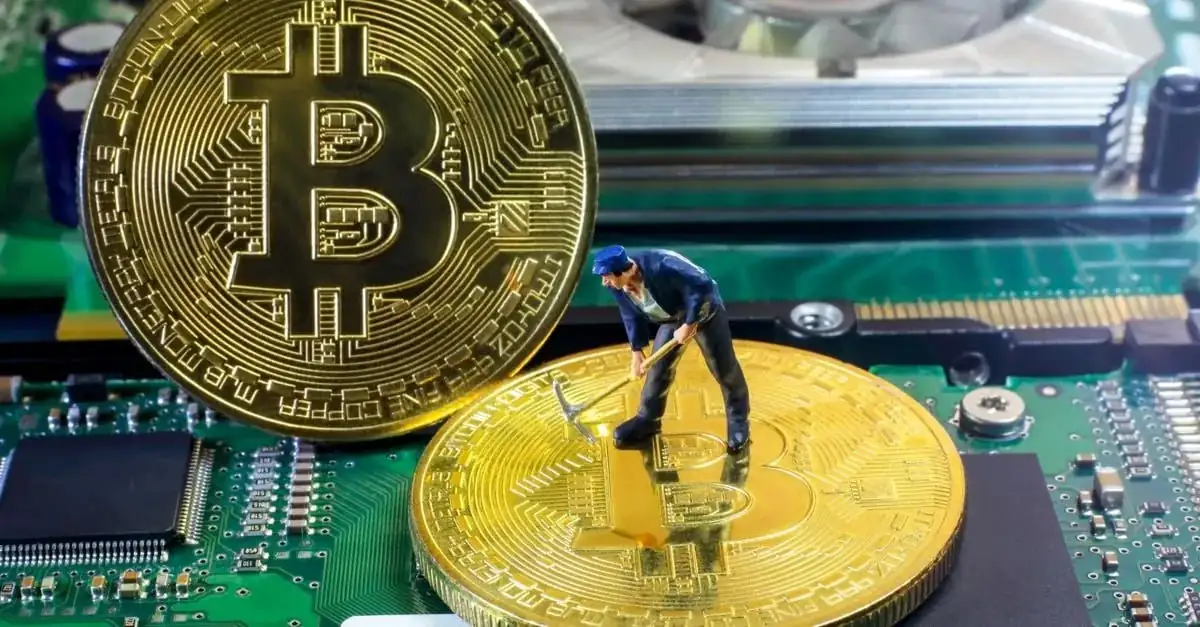As we progress through the 21st century, financial markets and economies evolve. The rise of digital currencies, or cryptocurrencies, is one such evolution that has taken the world by storm. Cryptocurrency mining is at the forefront of this digital revolution, forming the backbone of cryptocurrency transactions.
Crypto mining is a complex process, but it is crucial to the functioning of the cryptocurrency world. It's the method through which new digital coins are brought into existence and transactions are verified. In essence, crypto mining is a computerized process that requires high-powered systems to solve intricate mathematical problems.
Although it might seem like a modern gold rush, crypto mining is not just about making quick money. Our view at PlasBit is that it is vital to maintaining, developing, and expanding the cryptocurrency network. In this article, we will explore the world of the cryptominer to unravel its mysteries and provide insightful analysis.
Understanding the Basics of Cryptocurrency
Before we delve into the nitty-gritty of crypto mining, it's essential to understand the basics of cryptocurrency. A cryptocurrency is a form of digital currency that utilizes cryptographic security. It is decentralized and operates independently of any central bank, meaning any government or financial institution does not control it.
The original cryptocurrency is Bitcoin, developed in 2009 by an anonymous individual or collective under the pseudonymous identity of Satoshi Nakamoto. Since then, thousands of cryptocurrencies, commonly known as altcoins, have emerged, each with unique properties and functionalities.
Cryptocurrencies operate using blockchain - a decentralized system distributed across many computers that manage and record transactions. Essentially, a blockchain is a public ledger of all transactions that have ever happened in a particular cryptocurrency.
Examining the Cryptominer Process
Crypto mining involves producing solutions to complex mathematical problems using computer hardware. This process is also known as proof-of-work (PoW). When a problem is solved, the miner gets to add a transaction block to the blockchain, rewarding them with a certain amount of cryptocurrency.
The process begins with miners competing to solve a complex mathematical problem. This conundrum is based on a cryptographic hash algorithm. A solution is a number that, when hashed, produces a result within a specific range.
Once a miner finds this number, they broadcast the uncovered solution to the rest of the network. Other miners then check this solution; the block is added to the blockchain if correct. The miner who found the solution is rewarded with some cryptocurrency.

Why Crypto Mining Matters?
At PlasBit, we acknowledge how crypto mining is pivotal in maintaining, growing, and securing the blockchain infrastructure.
Adding new transactions:
Cryptominer activity is instrumental in adding new transactions to the blockchain. Miners solve complex mathematical problems, and in the process, they validate the transactions made across the network. This process is crucial for ensuring the authenticity of every cryptocurrency transaction, thus maintaining the integrity of the blockchain.
Bringing new cryptocurrency into circulation:
Miners receive newly minted coins in reward for their arduous task of solving complex problems and validating transactions. This process is how new bitcoins were and still are brought into existence, contributing to the overall cryptocurrency market.
Securing the network:
Crypto mining provides security for the cryptocurrency network. The miners' effort to solve mathematical problems also means they are constantly fortifying the network against fraudulent activities. The greater the number of miners, the more secure the network, as any potential hacker would have to control more than 50% of the network's computational power to tamper with it.
Therefore, crypto mining is not just a means for individuals to earn cryptocurrencies but a fundamental process that maintains the entire blockchain system's operation, security, and growth. This backbone allows cryptocurrencies and the decentralized systems they support to function effectively and securely.
Cryptominer: Different Methods Explored
Several methods are available to a cryptominer, each with advantages and disadvantages. Each method is designed to suit different types of miners depending on factors such as technical knowledge, resources, and risk preference.
Solo mining:
Solo mining is the most traditional form of crypto mining. It involves an individual miner using their mining hardware to solve complex mathematical problems that validate transactions. The rewards for successful mining are high, but so are the risks and costs. This method requires significant technical knowledge, high upfront investment in hardware, and a considerable amount of electricity.
Pool mining:
In pool mining, multiple miners combine their computational power to solve the puzzles. The rewards are then distributed among the pool members relative to the computational power they have contributed. This method reduces the risk and cost associated with mining, making it a popular choice for beginners and those with limited resources.
Cloud mining:
Cloud mining offers a more hands-off approach to cryptocurrency mining. It involves leasing mining hardware from a service provider who manages the entire mining process. The miner pays a fee for this service, and in return, they receive a portion of the mined crypto. This method eliminates the need for technical expertise and high upfront costs, but it also comes with its own set of risks, including the potential for scams.
Understanding these different methods empowers the potential cryptominer to choose the best approach for their needs and circumstances.
Analyzing the Profitability of Crypto Mining
Crypto mining profitability rests on various factors, including electricity cost, the price of the crypto being mined, the difficulty of the mathematical problems, and the mining hardware's efficiency.
Electricity costs:
The cost of electricity is one of the most significant factors affecting the profitability of crypto mining. Mining cryptocurrencies involves solving complex mathematical problems, which require significant computational power. The machines used for this process consume a large amount of electricity. In regions where electricity is expensive, running these machines can outweigh the profits made from mining. Therefore, miners often set up their operations in countries where electricity is cheap. The lower the electricity cost, the higher the profit margins for miners. Miners must consider this aspect when setting up their mining operations.
Price of cryptocurrency being mined:
The price of the crypto being mined is another crucial factor affecting the profitability of mining cryptocurrencies. The reward for mining a block of a particular cryptocurrency is a certain amount of that cryptocurrency. The reward is more valuable if the cryptocurrency price is high, making the mining operation more profitable. However, cryptocurrency prices are volatile and can fluctuate widely. This volatility can make mining more risky, as a sudden drop in price can significantly reduce the profitability of mining cryptocurrencies.
The difficulty of mathematical problems:
The difficulty of the mathematical problems that must be solved to mine a cryptocurrency also impacts profitability. The more complex the problem, the more computational power is required. This scenario means more electricity consumption and a longer time to mine a single block. The difficulty of mining a cryptocurrency adjusts over time, usually increasing as more miners join the network. Mining can become less profitable if the difficulty increases faster than the cryptocurrency's price.
The efficiency of mining hardware:
More efficient hardware can solve the mathematical problems required for mining more quickly, which means they can mine more blocks in the same amount of time. Furthermore, more efficient hardware often uses less electricity, which can significantly reduce the cost of mining. Therefore, investing in efficient mining hardware can significantly increase the profitability of a mining operation. However, high-quality mining hardware can be expensive, and the technology continually evolves, leading to potentially high initial and upgrading costs.
Cryptominer Risks and Challenges
The realm of cryptocurrency mining, while lucrative, is replete with numerous risks and obstacles. At PlasBit, we believe it is valuable to be aware of these and to understand them.
One of the most significant challenges miners face is the extreme volatility of the cryptocurrency market. Cryptocurrencies' prices fluctuate dramatically and unpredictably, affecting the profitability of mining cryptocurrencies. When the price of the mined cryptocurrency falls significantly, it can render the mining operation unprofitable.
Another considerable risk is the escalating complexity of the mathematical problems that must be solved in mining. As the network grows and more miners try to solve these problems, they become increasingly complex. This increase in difficulty necessitates more sophisticated computing power and higher energy consumption, hiking up the cost of mining.
Furthermore, the risk of equipment failure poses a substantial challenge. Cryptocurrency mining necessitates using high-powered computer hardware that can be subject to breakdowns or rapid obsolescence, leading to potential losses and downtime.
Lastly, there are security risks inherent to the digital nature of cryptocurrencies. Cryptocurrencies are a prime target for hackers since they are purely digital. Security breaches can lead to significant losses if the mined cryptocurrencies are stolen. Therefore, crypto miner investment must also include robust security measures, adding to the overall cost and complexity of cryptocurrency mining.
How to Get Started with Crypto Mining
Getting started with crypto mining requires some investment in hardware and a good understanding of how cryptocurrencies work. Here are some steps to get started:
1. Choose a cryptocurrency to mine:
Some cryptocurrencies are more accessible to mine than others. Do your research and choose a cryptocurrency that is right for you.
2. Get the proper hardware:
Depending on which crypto you choose to mine, you will need specific cryptominer hardware. This system could range from a powerful PC to a custom-built mining rig.
3. Join a mining pool:
While it's possible to mine alone, joining a mining pool can make the process more stable and less risky.
4. Install a mining program:
You will need a program to run the mining process. There are many programs available that are compatible with different types of hardware.
5. Start mining:
Once you have your setup complete, you can start mining. Keep an eye on the market and adjust your mining strategy as necessary.
Remember, choosing a secure wallet for storing crypto mined by a cryptominer is also crucial. It ensures the utmost safety of your digital assets, preventing unauthorized access and potential loss. At PlasBit, our crypto wallet provides robust security features like two-factor authentication and private key encryption, making it difficult for hackers to steal your crypto. It's not just about storage; it's about protecting your hard-earned digital wealth from the ever-present threats in the crypto landscape. We also provide crypto debit cards and wire transfer services that allow flexible access and use of funds generated from cryptominer activity.
Crypto Tools: Using a Crypto Mining Calculator
A crypto mining calculator is an essential tool for cryptocurrency mining. It calculates the profitability of mining cryptocurrencies, considering factors such as your rig's hash rate, electricity costs, and the current price of the cryptocurrency.
One of the main benefits of using a crypto mining calculator is that it allows miners to predict potential earnings and make informed decisions. It helps identify the most profitable currencies to mine, thus optimizing the return on investment. Without a crypto mining calculator, miners might spend more on electricity and equipment maintenance than they earn from mining.
The mining calculator we provide at PlasBit gives a comprehensive analysis of your potential earnings based on your input data. It considers the mining hardware's hash rate, power consumption, electricity cost, and the cryptocurrency's current value. Using our mining calculator, miners can efficiently plan their operations and maximize their cryptominer profitability.
Future Prospects of Crypto Mining
The future of crypto mining looks promising, but it is also uncertain. With the increasing popularity of cryptocurrencies, more people are getting involved in mining, driving up the difficulty of the mathematical problems and the energy demand.
This increased demand has led to environmental concerns about the impact of crypto mining. Some cryptocurrencies are looking at alternative methods to less energy-intensive proof-of-work, such as proof-of-stake.
There is also the possibility of regulatory changes. As cryptocurrencies become more mainstream, governments worldwide are looking at ways to regulate them. This trend could have a significant impact on the future of crypto mining.
Cryptominer Activity: A Vital Role
Crypto mining is a complex but fascinating process. It is the backbone of the cryptocurrency world, responsible for verifying transactions, bringing new coins into circulation, and providing security for the network. While it comes with risks and challenges, significant rewards are also possible.
The crypto-mining world will likely continue evolving as we look to the future. With increasing interest in cryptocurrencies, technological advancements, and potential regulatory changes, the only certainty is that the crypto mining landscape will continue to change. Despite the uncertainties, one thing remains clear: crypto mining will remain a vital activity in cryptocurrencies.







